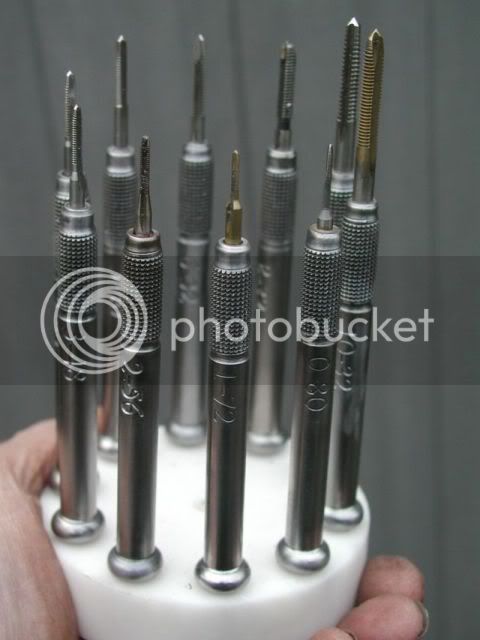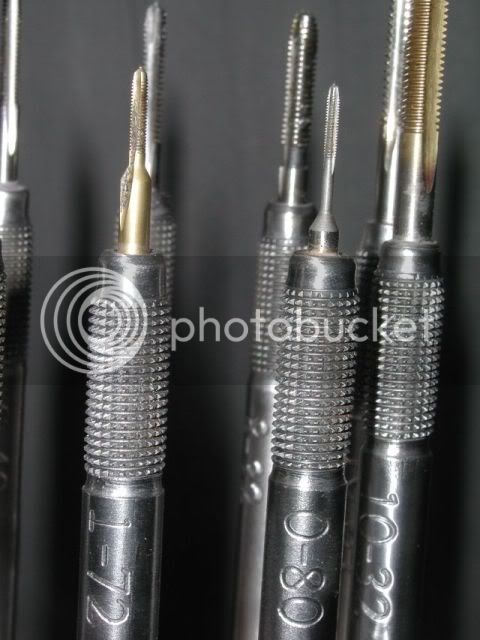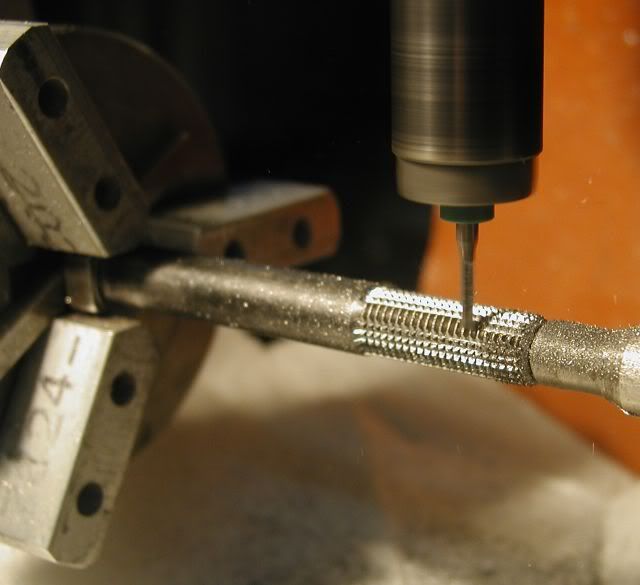This is mainly a take off of Marv Klotzs suggestion of using pin chucks for tap handles.
Made these tap handles couple of months ago and they have been working good for me.


They are made from 7/16-20 bolts, which had a surplus of. The hex head end is drilled for slip to sloppy fit for a ¼ rod to slide in and then the hex is rounded over with a form tool.
The threaded end was left with the threads on and made into a cut knurl by using edge of end mill cutting on the corner and indexing close to the pitch of the thread. Having a home made cnc mill with home brew indexer made this job easy. Using the cnc the size of tap was engraved on the tap handle shank.

Back to the lathe the end was drilled for slip fit of tap shank to fit in and used Loctite to hold the tap in. When tap needs replacing it can be heated up to break the bond and removed.
If drilling and tapping in the mill or lathe a ¼ rod can be held in chuck and tap handle slipped on that for a guide and tapping by turning by hand using the cut knurl for gripping with the fingers. The cut knurl is sharp and gives a good grip for turning.
In the lathe sometimes dont use a guide rod in end of tap holder but leave the tap drill in the tailstock chuck and rest back of hand on drill for aiming back of tap while starting to tap. This sounds like could be trouble but havent had any problems yet. It is easy to let the tap handle spin in your hand if things dont feel right.
Me thinks an easy way to break taps is to have the work rigidly fixed in a vise or chuck and to free hand tap. Without a guide it is easy to get started crooked or not turning evenly and trying to bend the tap.
I tap a fair amount freehand with out guide but what works for me is to be sitting down and holding the work in one hand and the tap in the other hand and elbows to side so they are free to move where ever they want. Not saying this is a good idea but it does work for me. Nice thing about doing it this way is that it is easy to judge when the tap is getting dull. Just for ideas not suggesting you do it this way.
Gary
Made these tap handles couple of months ago and they have been working good for me.


They are made from 7/16-20 bolts, which had a surplus of. The hex head end is drilled for slip to sloppy fit for a ¼ rod to slide in and then the hex is rounded over with a form tool.
The threaded end was left with the threads on and made into a cut knurl by using edge of end mill cutting on the corner and indexing close to the pitch of the thread. Having a home made cnc mill with home brew indexer made this job easy. Using the cnc the size of tap was engraved on the tap handle shank.

Back to the lathe the end was drilled for slip fit of tap shank to fit in and used Loctite to hold the tap in. When tap needs replacing it can be heated up to break the bond and removed.
If drilling and tapping in the mill or lathe a ¼ rod can be held in chuck and tap handle slipped on that for a guide and tapping by turning by hand using the cut knurl for gripping with the fingers. The cut knurl is sharp and gives a good grip for turning.
In the lathe sometimes dont use a guide rod in end of tap holder but leave the tap drill in the tailstock chuck and rest back of hand on drill for aiming back of tap while starting to tap. This sounds like could be trouble but havent had any problems yet. It is easy to let the tap handle spin in your hand if things dont feel right.
Me thinks an easy way to break taps is to have the work rigidly fixed in a vise or chuck and to free hand tap. Without a guide it is easy to get started crooked or not turning evenly and trying to bend the tap.
I tap a fair amount freehand with out guide but what works for me is to be sitting down and holding the work in one hand and the tap in the other hand and elbows to side so they are free to move where ever they want. Not saying this is a good idea but it does work for me. Nice thing about doing it this way is that it is easy to judge when the tap is getting dull. Just for ideas not suggesting you do it this way.
Gary




